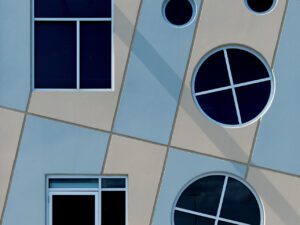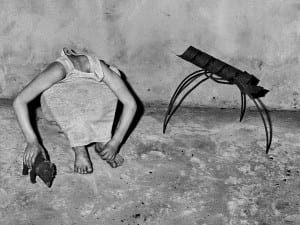Casey Orr (b. 1968) is distinctly interested in the lives of women – in their relationships with themselves, the notion of home, nationhood, individuality as well as a sense of belonging. This line of questioning has taken Orr across the globe, exhibiting portraits extensively across the USA and in numerous galleries, museums and festivals in the UK, including The Palace of Westminster, Tate Exchange, Tate Liverpool, Brighton Photo Biennial, Yorkshire Sculpture Park, National Portrait Gallery, and at HM Prison, Leeds – the first time the walls of a prison have been used as a space for art.
The Saturday Girl series (2013-present) is an award-winning collection of portraits of young women, shot across the UK, on Saturday afternoons in town centres. In this ground-breaking series, Orr would advertise her pop-up studio, invit- ing members of the general public to be part of a photographic project that celebrated the “sparkling potential” of the weekend, and to respond to the call: “see and be seen.”
In doing so, Orr brought the history of the “promenade” to 21st century culture, exploring the politics of watching and interpreting one another, whilst tapping into identity and gender politics as they rapidly shifted. In 2019, the series won the Format Festival Award, and this October, Bluecoat Press will be publishing the project as a photo-book. The latest iteration of the project, Saturday Girl About Town, is currently being shot, until March 2022. During these months, Orr is collaborating with local communities and high street action zones, creating studio sessions adhering to Covid restrictions in empty shops, and delivering live talks and exhibitions in Burnley, Blackpool, Wigan and Redcar.
A: How did the idea for Saturday Girl begin? Was there a distinct moment that inspired the series?
CO: It began in Leeds in 2013. I started noticing young women with “big hair”: backcombed 1960s-style; teased and sprayed; with wigs and hair pieces. I started wondering what it meant in terms of culture, tribe identities and values, and how these things burst forth in the unspoken languages of fashion and bodily self-expression. This vocabulary is passed down playfully through the generations, with changes that respond to cultural undercurrents, whilst sharing a connection to the past. I decided to only photograph on Saturday afternoons when city centres and high streets were a place of shopping and hanging out – looking and being looked at – promenading.
A: How did the idea develop into a UK-wide series – from Leeds to Glasgow; Preston to Belfast? As such a broad project, how has it affected the ways you see yourself, as well as the people you pass on the street?
CO: In 2015, I took my pop-up portrait studio to Liverpool. It was here that I started to wonder about regional differences in the language of fashion and the body. Liverpool women just blew me away with their style. The Liverpool aesthetic of wearing curlers in your hair whilst out shopping on a Saturday afternoon is just so playful and expressive, saying to the world: “I’m going out tonight!” I wondered if other cities were as individual, and if the culture of a place could be read by the ways women chose to look. I decided to take the studio on the road, to visit towns throughout the UK and find out. I visited 15 cities and photographed over 600 people, and, yes, landscape, economics, demographics and a local filter play a part in how we present ourselves, but we are also deeply connected to a wider conversation that flows through our lives. It seems that with every question I ask with photog- raphy the answer is always: “Everything is connected.”
A: How far was the series governed by its subjects: those who responded to an open call? How much choreography was involved in each of the compositions? Beyond the pop-up studio, were the shots pre-meditated?
CO: Saturday Girl is documentary photography. The portraits aren’t styled beyond the personal decisions made in front of bedroom mirrors. These images are a document of culture, read through fashion. Most of the people I photo- graphed were approached on the street that day. The project acts as a witness to these young lives. The series continues to excite me as it evolves and refers to the times in which we live, as well as a shared past that is being reinvented. In this way, I feel connected to other past lives – to my younger self – and to the present moment all at once. I am reminded that we all share a language that is at once steeped in culture, history and memory, and is also inherently fluid and changing. Fashion and physical expression are important and powerful tools for us all, to state who we are beyond consumerism and capitalism; beyond selfies and social media platforms.
A: To what extent is the project about exploring the semantics of identity – the signs with which we express who we are, what we value, where we come from and how we spend our free time? How does this tap into our belonging within social groups: platonic, familial and romantic?
CO: The work is absolutely about this. It is about what happens when, through the hypervisibility of our coming-of-age years, we begin to use this language. It is superpower; it is joyful creativity and play. We are informed by the self, our local context, family, community, economics and the wider landscape. Fashion is used as a way to find tribes, share values and be with like-minded people. It is a way to claim individuality, and also step in line with the masses.
A: Many of your images – and especially the curated collages – demonstrate how high street trends proliferate in culture, grouping individuals together by the way they style their hair, the cuts and colours of clothing, or the brands by which they associate. Has it made you think differently about individuality, in the ways we seek this out, or the ways we are distinctly similar?
CO: There are trends that filter throughout UK culture and can be followed without spending a lot, but there is a wider pool of inspiration that has occurred since the rise of social media and camera phones. This has empowered young people and LGBTQIA communities with a platform, and enabled people to find a multitude of possibilities beyond what they see from mainstream channels. There is always a dance between individuality and group identity; wanting to belong to a community whilst also aspiring to be a “distinct” person. Getting that right is a fine balance. The collages are photographic typologies in which shared elements denote a kind of relationship. Photographing is, essentially, collecting.
A: The portraits are intimately poised; how did you navigate the lines between authority and vulnerability with the women you photographed? Should documentary photography always be contractual? And does this need to be revisited as our self-awareness changes?
CO: Making a portrait is always an agreement, both spoken and unspoken. I want the person to understand what being photographed for Saturday Girl means and in what context their image might appear as part of the public face of the project – in books and exhibitions. I also want the person to feel seen, to have a say in how they are portrayed. The best portraits are self-aware, multi-layered and vulnerable, whilst also holding agency and a sense of self. It is such an intimate and humbling process when it works. I feel a responsibility to everyone in the work, many of them are so very young when they agree to be photographed. Everyone signs an image release form. Some individuals have asked to be removed from the project later, which I always do. I want them to think about what they are entering into by participating.
A: You’ve noted that, throughout the years between 2013 and 2019, the series began to be redefined as “the male and female labels began to fall away to be replaced with more fluid identities and freedoms.” How important was it that the series be defined by anyone and everyone who wanted to take part, or identify as a “Saturday Girl?” In what way did the title of the project become much more than the sum of its parts, as an inclusive concept?
CO: When I started the series, the word “girl” had a much different, and perhaps simpler, label. I was setting out to photograph young women. However, since then, the deconstruction of gender identity has filtered throughout the project, and our binary understanding of identity is gone. To see this limiting idea of who a person can be fall apart in matter of years is so hopeful – so inspiring. There is much that needs dismantling in this world of invisible assumptions and systems of power. The collapse of the gender binary gives me hope for the changes we need throughout society. As a photographer, I am trying to learn, listen, and follow these changes in culture. It is essential to stay in this flow of ideas.
A: Moving forward, what questions are you exploring with the next iteration of Saturday Girl About Town?
CO: Since Covid, young people have been away from each other, and the physical social spaces of self-discovery. This time has altered society in ways which aren’t even evident yet. It has been isolating and life-changing in a multitude of ways. Although, young people are already using creative, life-affirming body language in response to Covid, social distancing, masks and their new reality. The 2021 series will be set in smaller towns, as opposed to larger cultural centres and cities. It starts in Burnley, Redcar, Blackpool and Wigan. The work expands beyond the portrait to include the chang- ing high streets, documenting the places that have been damaged by online shopping, which has, in turn, been accel- erated by the pandemic. The project will contribute to local and national conversations that are shaping new spaces for community, play, fashion and identity. I ask: “Who owns the high streets?” In the process, I’ll be working closely with local authorities, educators and creatives in each town, and with a team of people headed by Creative Producer and Curator James Lawler, and Open Eye Gallery Director Sarah Fisher. There will also be an exhibition at Open Eye Gallery in 2024 celebrating the 10-year anniversary of Saturday Girl.
Words
Kate Simpson
Saturday Girl is published by Bluecoat Press
bluecoatpress.co.uk caseyorr.com
Image Credits: All images by Casey Orr, from the Saturday Girl series.











